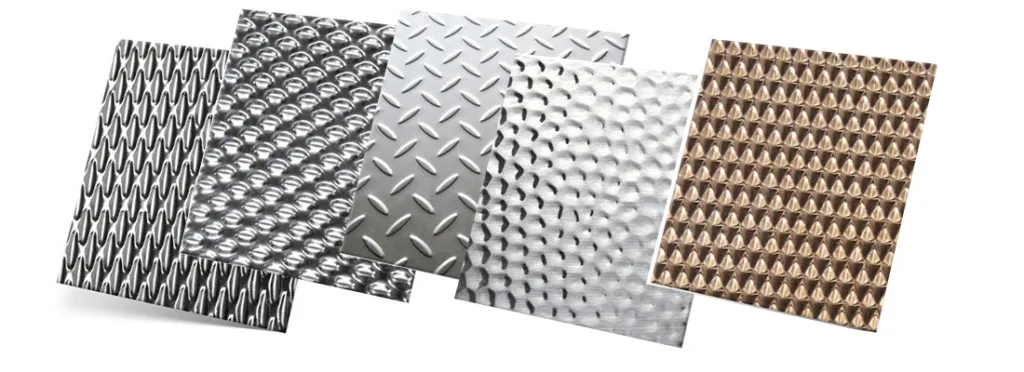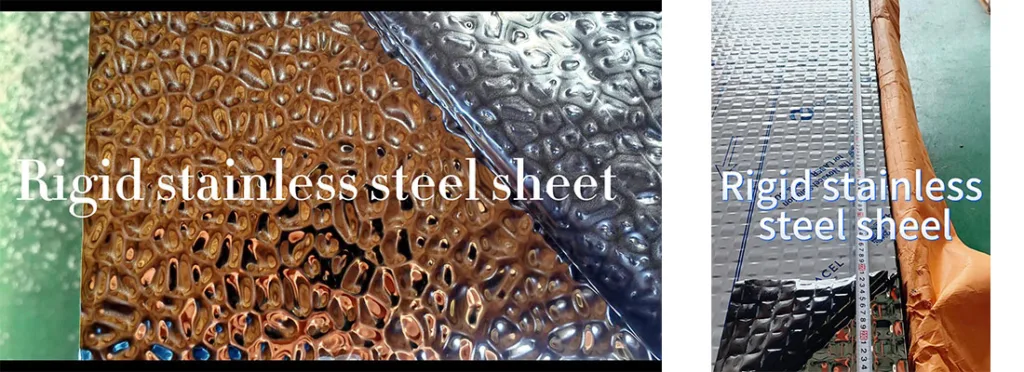In the realm of modern design and construction, textured sheet metal has emerged as a go-to material for those seeking both visual appeal and durability. Whether used in architecture, furniture, signage, or art, textured sheet metal offers endless design possibilities, combining the aesthetic power of metal with functional strength. This versatile material has found its way into both high-end commercial projects and residential designs, proving its worth as an essential element in today’s design landscape.

In this blog, we will dive into what textured sheet metal is, explore its key benefits, discuss its various applications, and offer tips on how to choose the right type of textured sheet metal for your next project.
What is Textured Sheet Metal?
Textured sheet metal refers to metal sheets that have been treated or processed to create unique surface patterns and textures. These textures can range from subtle finishes to bold, intricate patterns and can be applied to a variety of metals including stainless steel, aluminum, copper, and brass. The process of creating textures can involve rolling, embossing, etching, or even laser-cutting the metal to achieve the desired effect.
This treatment transforms otherwise flat, plain metal surfaces into visually dynamic materials that can be used to add depth, light reflection, and a modern touch to any project. Whether you choose a sleek, brushed texture or a striking geometric pattern, textured sheet metal is versatile enough to fit almost any design style.
Key Benefits of Textured Sheet Metal
Aesthetic Appeal
One of the standout qualities of textured sheet metal is its ability to elevate the visual appeal of any space or design. Textures can range from smooth, subtle patterns to bold, eye-catching designs that create a striking effect. When light hits these textured surfaces, it reflects in different ways, adding depth, dimension, and movement to the material. Whether used in interiors or exteriors, textured metal adds a touch of sophistication and modernity to the environment.
Durability and Strength
Textured sheet metal retains the inherent strength of the base metal, which makes it an excellent choice for both indoor and outdoor applications. Metals like stainless steel and aluminum are known for their resistance to corrosion, rust, and general wear. This makes textured sheet metal ideal for areas exposed to harsh conditions, whether it’s the exterior of a building or in high-traffic commercial spaces.
Low Maintenance
Another significant benefit of textured sheet metal is its low maintenance requirements. Unlike other materials that require frequent cleaning or special care, metal is easy to wipe clean. A simple damp cloth is often enough to remove dirt or debris. The durability and resistance to staining make textured metal a long-lasting solution for both decorative and functional applications.
Versatility
Textured sheet metal can be adapted to a wide range of applications, from creating industrial design pieces to luxurious decorative finishes. Its versatility makes it suitable for both commercial and residential projects. Whether you’re designing an architectural facade, crafting custom furniture, or creating a bold piece of art, textured sheet metal can meet a variety of aesthetic and functional needs.
Applications of Textured Sheet Metal
Architectural Design
Textured sheet metal is widely used in modern architecture for creating exterior facades, wall panels, and cladding. The texture adds visual interest to otherwise flat surfaces and can enhance the overall appearance of a building. The reflective quality of metal surfaces can also play a key role in creating dynamic lighting effects, giving buildings a sleek, polished look. Textured sheet metal is particularly effective in high-end commercial buildings, luxury residences, and modern office spaces.
Interior Design
In interior spaces, textured sheet metal is used for a variety of purposes including wall panels, partition screens, and ceilings. Its modern and industrial aesthetic is perfect for creating feature walls in living rooms, kitchens, or bathrooms. Textured metal can also be used for creating custom doors, accent pieces, and even furniture elements, like tabletops or backs of chairs, providing a seamless blend of form and function in your interiors.
Furniture Design
Textured sheet metal adds a unique, industrial touch to custom furniture pieces. From minimalist tables to bold, statement-making shelving units, the material can be used in a variety of furniture designs. The contrast between the cold, metallic texture and other materials like wood or glass creates a striking visual effect that suits both modern and industrial design styles.
Signage and Branding
The visual impact of textured sheet metal makes it an excellent choice for branding and signage. Businesses often use textured metal to create standout signs that catch the eye. The durability of the material ensures that the signs withstand the elements, whether they’re placed indoors or outdoors. Textured metal signs are used in commercial buildings, hotels, restaurants, and retail stores to create a professional, lasting impression.
Custom Design and Artwork
Artists and designers have embraced textured sheet metal for custom art pieces and installations. Whether it’s a wall sculpture, a custom-designed panel, or a larger installation piece, textured sheet metal adds depth, dimension, and visual intrigue. The ability to manipulate light and shadow through different textures gives these pieces a dynamic, evolving presence that changes depending on the lighting conditions.

How to Choose the Right Textured Sheet Metal
When selecting textured sheet metal for your project, here are a few factors to consider:
Material Type
The material you choose will depend on the specific requirements of your project. Stainless steel is a popular choice due to its strength, corrosion resistance, and sleek, modern look. Aluminum is lightweight and highly corrosion-resistant, making it suitable for a wide range of applications. Copper and brass are more decorative metals that can add warmth and character to your design.
Texture Pattern
There are many different textures available, ranging from simple, linear patterns to more complex, geometric designs. The texture should align with the overall aesthetic of the space or project. For example, sleek, subtle textures may be better suited for modern office buildings, while bold, textured patterns could work well in industrial-style spaces.
Finish
The finish of the metal will impact its overall appearance and feel. Options include matte, brushed, polished, or mirror finishes. Consider how the finish will interact with the light and the surrounding materials in your design. A polished finish will create more reflection, while a matte finish provides a more subdued, elegant look.
Thickness and Durability
The thickness of the sheet metal depends on its intended application. For outdoor use, thicker sheets may be needed to withstand weather conditions, while thinner sheets may be sufficient for indoor use. Ensure the metal’s thickness aligns with the demands of your project, particularly if it will be exposed to heavy wear and tear.
Conclusion
Textured sheet metal is an incredibly versatile material that brings together the best of both worlds: aesthetic beauty and unmatched durability. Its applications in architecture, interior design, furniture, signage, and art make it a key material in modern design. Whether you’re working on a large-scale commercial project or a custom-designed piece, textured sheet metal offers endless creative possibilities.
If you’re considering incorporating textured sheet metal into your next design project, be sure to choose a trusted supplier that offers high-quality materials and a wide range of textures. With the right texture and finish, textured sheet metal can transform your design and leave a lasting impression.
